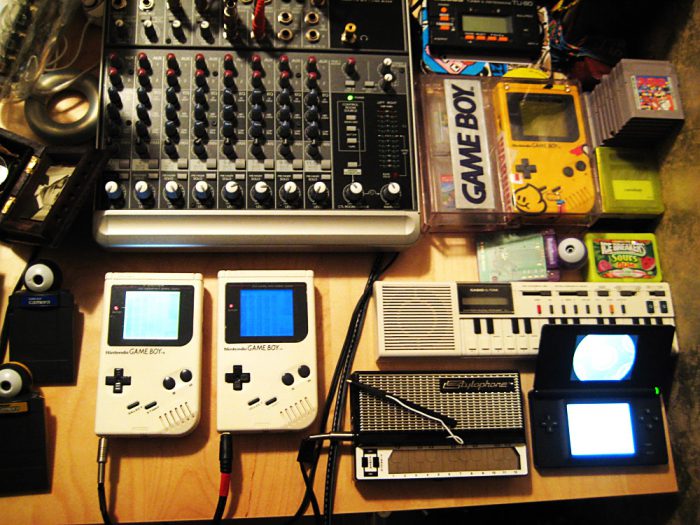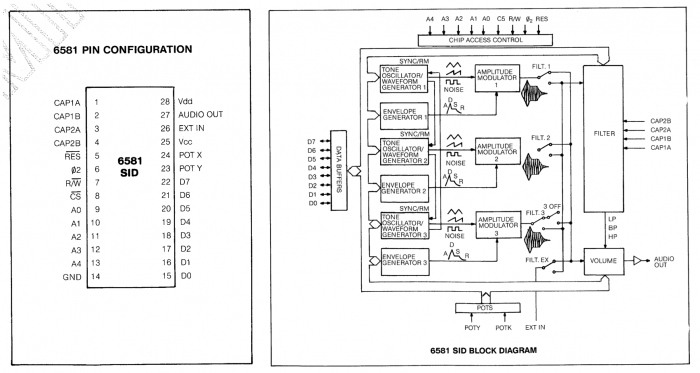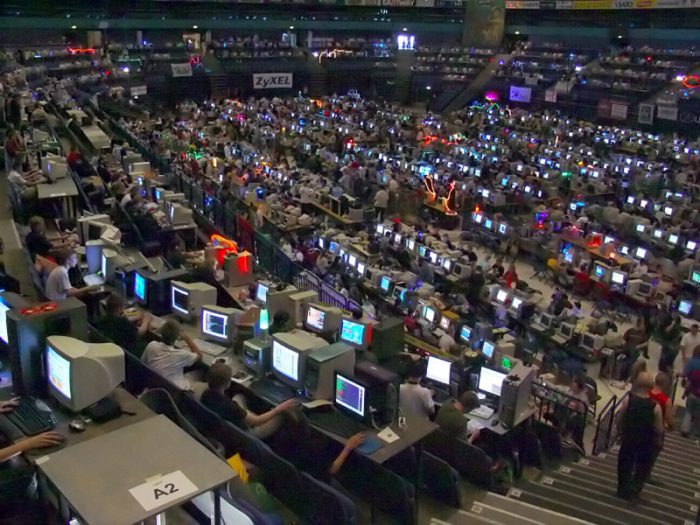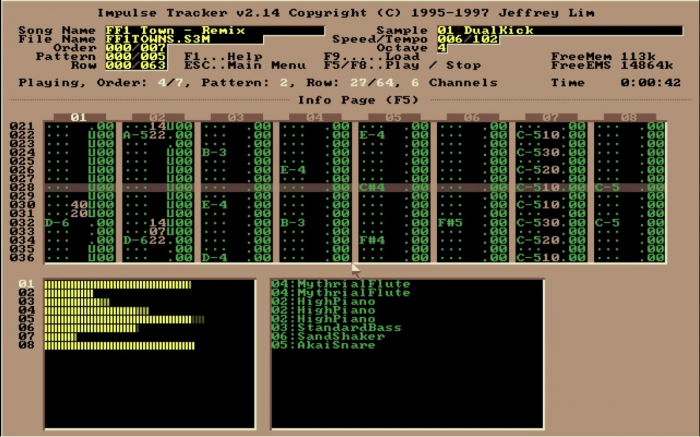Sonic Excavations #1 | Chip Tune
- par La COGIP

And the bit goes on
For the sake of your sacred ears, Le Périscope dives into the archives of L'Influx, the Webzine of the Lyon Municipal Library and collects all its musical curiosities and adventures. Today, we focus on Chip Tune genre, an emblematic musical style of all 80's videogames' soundtracks, summarized and detailed by the teams of the music department of the library. The entire Influx music archive can be found here.
Sounds of 1980’s videogames are at the base of a seriously playful musical trend named Chip Tune. Its sound range is limited by the technical limitations of the electronic chips it exploits: a narrow infinity that encourages creative excess to distinguish itself and make the 1s and 0s groove.
Introduction : ChipTune and retro-gaming
The term ChipTune, literally a tune produced with the help of a computer chip, refers to the music composed for the first game consoles, arcades, and microcomputers in the 1980s. By extension, it refers to all music created from these electronic chips that populated 8-bit consoles (from 1983 to the early 1990s), which is why it is also referred to as 8-bit music.
A real music scene Chiptune has developed in parallel with the video game culture, and with the gradual rise of the retro-gaming culture (to go very quickly, the passion for old-time video games). So it’s as much about the composers of the original video game music composers of the ‘demoscene‘ (a computer subculture gathering creators in the fields of music, computer graphics and programming), as it is about the artists of the electro scene influenced by the retro video game aesthetic.
The retro-gaming is now a planet, if not a parallel universe. Technologically stuck in the previous decades and more particularly in the 80s, its inhabitants do not want to leave the first golden age of digital possibilities. To remain faithful to it is not a refusal of technology, but a partly nostalgic immersion in a dated representation of the future, more naive, simplistic and even poetic than the one we see today. It is for many fans a return to childhood, and for the youngest an almost archeological detour to the origins of the video game (now considered a sport).
Confronted with these low-resolution sounds, your degree of auditory nostalgia will depend on your generation: in the 1980s, the generation X (born between 1965 and 1979) were teens, the generation Y (born between 1980 and 1995) were kids. For them the characteristic blips and blops are so many Proust’s madeleines (and for the followers of the Ferrari Grand Prix Challenge game, Prost’s madeleines). For the millenials (generation Z, born from 1995 onwards), these sounds evoke a distant past, and at the same time familiar because it has crossed the times, as we will see and hear.
Rhythms, basslines, and solo instrument intertwine in a crackling lo-fi mush that is quickly wearying to our 2021 ears, but melodic and grand to its many followers.
A few songs to start off :
- Arkanoid (Martin Galway, C64 – 1987)
- Xenon (David Whittaker, Atari ST – 1988)
- Ferrari Grand Prix Challenge (Neil Baldwin, NES – 1992)
Technically speaking : the Chip Tune Sound
The music and sounds of videogames on first generation consoles (and computers) such as Atari 2600, Commodore 64, and Nintendo Gameboy are synthesized and generated in real time by a dedicated computer chip (C64) or via the main processor (Gameboy and NES), which plays the programmed score and sounds specific to the game (today, thanks to the much larger computer memory capacities, the music and sound design are mostly based on prerecorded samples).
The most famous for purists is the one present in the Commodore 64, of American design. One of the most popular machines in the early 80’s, ahead of the competition in terms of memory in particular (64 KB!). Its chip dedicated to sound is the SID (Sound Interface Device), or MOS 6581 and was created by Bob Yannes, later co-founder of the firm Ensoniq (behind the famous Mirage sampler)

The limited number of voices (or channels, tracks) usable with these primitive chips makes it difficult to produce rich, polyphonic music. The SID is a chip/synthesizer with 3 voices only (3 sounds playable simultaneously).
A quick but necessary trip to the tech booth, time for an enlightening Wikipedian explanation (I promise):
” Most of the sounds in these circuits are generated from very simple waveforms, such as sine waves, square, triangular, or sawtooth signals, and basic percussion (generated from white noise passing through a wrap generator). Some low-frequency oscillators were also used to control certain parameters throughout a cycle (…) “
A roundabout way to achieve a rich effect is to do very fast arpeggios (the notes of a chord, played in sequence rather than at the same time, to simulate the sound of a chord without having to use multiple tracks). The accumulation of notes, ascents and descents is typical of chiptune.
This series of 9 YouTube videos by user explod2A03 details (in English) the sonic possibilities of the NES and its chip created by Hirokazu Tanaka, with many examples:
Pioneers of the genre, the demo-scene…
From technical limitations and material constraints arises an adapted musical grammar, which requires for the composers, besides artistic talent, advanced knowledge in programming, and a keen sense of code tinkering. It is indeed a question of doing more with less, and of optimizing the compositions in terms of memory used and of trying to sound fuller despite the constraints. It’s the same issue visually, with pixels, and the challenge of creating recognizable characters (sprite) in just a few colored bricks.
Rob Hubbard
English composer born 1955.
He began his computer career as a developer of educational programs and even created a game. Success was not forthcoming, but the positive feedback he received, especially from the development company Gremlin Graphics, about the music in his programs persuaded him to specialize in this field. )
It was indeed necessary to be a coder as well as a musician in order to compose for video games: Rob Hubbard describes at the beginning of this video how he worked, without a plotter, without a sequencer, using the technique of assembler programming, which involves translating notes into hexadecimal code. Gymnastics that he eventually mastered like a new solfeggio.
One of the techniques he developed to create the illusion and simulate the big Hollywood production was to have the ‘instruments’ follow each other in quick succession, like so many participants taking turns playing their score. A strategy that can make you smile but that works quite well (in ” Monty on the run ” for example)
R. H, author of 75 Commodore 64 game soundtracks between 1985 and 1989, explains in this interview that he had to negotiate with the video game publisher to obtain at least 10% of the available memory in order to fit in music and sound design, and to allow him up to 10% of the processor activity.
In this excerpt from the documentary ‘From Bedrooms to Billions’, Rob Hubbard, Ben Daglish and Martin Galway explain some of their composing techniques (starting at 2:40):
Jeroen Tel
Dutch composer born in 1972. He was only 15-16 years old when he started with Charles Deenen the world’s first video game music company: Maniacs of Noise, still active today. Very active member of the ‘demo scene’, he is the author of a large number of music since 1987 for Commodore 64, NES, Sega Master System, Amiga.
Dutch composer born in 1972. He was only 15-16 years old when he started with Charles Deenen the world’s first video game music company: Maniacs of Noise, still active today. Very active member of the ‘demo scene’, he is the author of a large number of music since 1987 for Commodore 64, NES, Sega Master System, Amiga.
Hirokazu Tanaka
Japanese composer for Nintendo, he is the author of mythical soundtracks like Metroid
Tanaka also played a big role in the design and progammation of the audio hardware equipping the Gameboy and the NES (Nintendo Entertainment System or Famicom). A thousand places away from this universe, he is passionate about dub, with and its bass and sound effects, from which he draws some lessons for his compositions (limited to the 3 voices – or channels – of the chip). It is not rare that they contain minimalist passages bass + drums in the way of dub. Let us specify that the composers were free to experiment and were not yet under the pressure of publishers not to displease too much the housewife.
It is no stranger to the appropriation of machine sound by DIY hacker game players : By combining the Gameboy Camera accessory with a sequencer to manipulate sound, he opened the doors to the creation and musical exploitation of the Gameboy by amateurs, and certainly helped to spark vocations.
The documentary series produced by Red Bull Radio Diggin In The Carts, devotes 6 episodes to the Japanese pioneers of VGM (Video Game Music). Visible on Youtube, and with French subtitles (choose it in the settings), this doc is a mine of information on the Japanese side of the story. We meet the composers Junko Ozawa (composer for Namco), Hirokazu Tanaka (who we just mentioned), Masashi Kageyama (for the games Sunsoft), Hayato Matsuo, Hitoshi Sakimoto, Yoko Shimomura (composer of the mythical Street Fighter 2 for the Super Nes), Yuzo Koshiro (composer of the technoid Streets of Rage for Sega’s Megadrive), Nobuo Uematsu… Nintendo, Sega, and publishers Konami (the first to integrate an additional audio chip directly into the game’s cartridge – the VRC6), Sunsoft, Capcom are mentioned…
Koji Kondo
Absent from the documentary, Koji Kondo is another not-bad Nippon hero. We owe him the ultra cult music of Super Mario Bros, and its sequels, and also The Legend of Zelda, among other blockbusters.
Let’s also mention (in order of the playlist that follows David Whittaker, Chris Hülsbeck, Martin Galway, Tim Follin, Kinuyo Yamashita, Ben Daglish, Toshio Kai, Kris Hatlelid, Charles Deenen…
The demo scene: a counterculture
As said above, the ‘demoscene‘ is a computer community gathering amateurs and professionals, and whose objective is to exploit artistically (music, computer graphics, programming) the possibilities of computers: to push the machines to their maximum, for the beauty of the (technical) gesture.
Once again, Wikipedia says it well, why go without:
” The basic premise is to achieve technological/artistic performances by playing on programming tricks or real programmatic performances. The programs thus created are called demos (…)
The ” demo ” is therefore in a way a demonstration of the talents of their authors. “
These demos can be found in particular in the cracked video games (not to be made at home) of the time, on Amiga or Atari ST for example. Indeed, the games already contained in their code some anti-copying processes, that the computer scientists in the making tried to break. A computer challenge that became a widespread practice, even a competition between groups of hackers, code crackers, at the time of the BBS (Bulletin Board System = in a few words a network ancestor of the Internet). Once the software (games) cracked, these groups redistributed them by integrating the mark of their exploit in the form of an introductory screen containing multimedia animation and music: a demo or cracktro (crack introduction).

Examples of demos on Atari ST (video starts with a history and the show starts at 1:09
The music is made from software called trackers. The German composer Chris Hülsbeck is at the origin in 1986 with his program SoundMonitor for Commodore 64, destined to help him in his work. Followed in 1987 Ultimate Soundtracker, created by Karsten Obarski for the Amiga and then PC Master Race, Scream Tracker, Fast Tracker, Impulse Tracker… Many enthusiasts get hold of it and the musical creation on computer (almost all platforms are served) becomes more accessible.
A view of the very poetic Impulse tracker:

These programs characteristic of the demoscene nowadays seem a bit outdated as the tools of digital creation have developed and democratized. Moreover internet allows such a sharing of knowledge that the artistic emulation has changed its face.
But the demoscene still exists and gatherings are regularly organized, as evidenced by this article from Geekzone. And above all it endures philosophically, in its fight against obsolescence technological.
The current scene
The 80’s aesthetic is as you know in great shape in 2018. Who would have thought so?
Retro-gaming is stronger than ever, not least because gaming itself is doing extremely well
The development of this culture, in parallel with the democratization of computer music has kept alive and even revitalized the chip tune music scene, to which the magazine Tracks on Arte devoted a report already 10 years ago:
The music stream has a life of its own, independent of the gaming world.
As consoles (and their games) began to take their ease on the memory side in the 1990s, they abandoned the ‘synthesizer’ chip in favor of pre-recorded banks. The GameBoy, on the other hand, continued to integrate an old-fashioned architecture of sound synthesis. With the work of the hacker and tinker community helping, the Gameboy integrated a MIDI interface, allowing it to interact with other studio instruments using the same language, basically. Software such as Nanoloop, or Little Sound DJ (LSDJ) have appeared, making this platform attractive and accessible to amateurs.
So it often finds its way into the basic chiptune musician’s setup, with the operation of NES or C64 chips in comparison requiring more advanced and less purely musical technical knowledge.
A distinction can be made between artists referring to the sound of video games, sampling them (sound quoting), and artists producing sound partly or exclusively from the original hardware: gameboys, commodore, chips embedded in cobbled-together modules (Elektron Sidsation for example), trackers…
Crystal Castles or Kap Bambino for example, fall into the first category: The basis of their sound is not primarily chiptune, but that influence is very present in their tracks.
The other category is more of a musical niche, not intended to become mainstream. There is for example the Lyon-based 2080, of which here an interesting interview by retro-games.fr
Some of today’s chiptune artists are to be found on the side of online communities, forums and specialized sites, whose users compete with each other with remixes or original creations posted by palettes. They can also be found on the less specialized youtube.
The most exposed get out of their rooms/studios and perform at festivals dedicated to chiptune, or more broadly to electronic music. They are called 2080, Nullsleep, Bit Shifter, Random…
The 8-bit rework, an ironic obligatory passage:
A few links to finish:
- The 8Bit Collective community site is no more, but you can find on archive. org a selection of downloadable tracks, collected during its years of activity (2006-2011)
- The reference sites chiptune.co.uk and chipmusic.org
- The netlabel 8BitPeoples
- The demo scene can be found on Pouet.net
- This article on Geekzone
- This very good article on Point Final
- The Little-Known History of Trackers, another article from Geekzone
- An interesting history on TheConversation. com
- Another one on LacedRecords
- An overview of homebrew’ (unofficial) software to install on your Gameboy, to get you started.
- The podcast This Week In Chiptune, conducted by DJ Cutman from 2012 to 2017, with downloadable episodes.
- A top 100 made by users of the Rate Your Music discography site
This article was produced in partnership with the Webzine “L’influx” of the Lyon Municipal Library
